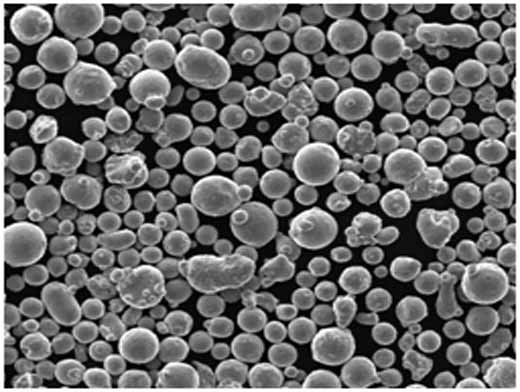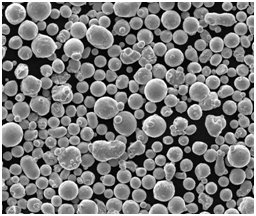Introduction
Poudre de CuAl10 est une poudre métallique de haute performance fabriquée à partir d'un alliage de cuivre (Cu) et d'aluminium (Al), contenant généralement environ 10 % d'aluminium en poids. Connue pour ses excellentes propriétés mécaniques et sa résistance à la corrosion, la poudre CuAl10 est largement utilisée dans diverses industries, de l'aérospatiale à l'électronique en passant par la fabrication additive. Si vous vous demandez ce qui rend CuAl10 si spécial, continuez à lire - nous allons nous plonger dans sa composition unique, ses propriétés et ses applications.
Composition de la poudre de CuAl10
Il est essentiel de comprendre la composition de la poudre CuAl10 pour comprendre pourquoi il s'agit d'un matériau si polyvalent. Cet alliage combine la conductivité du cuivre et les propriétés de légèreté de l'aluminium, ce qui le rend idéal pour les applications qui requièrent de la force et de la résistance à la corrosion sans trop de poids supplémentaire.
| Élément | Pourcentage en poids | Propriétés apportées |
|---|---|---|
| Cuivre (Cu) | 90% | Assure la conductivité, la ductilité |
| Aluminium (Al) | 10% | Ajoute de la force et de la légèreté |
| Oligo-éléments | <1% | Stabilise et affine les performances |

Processus de fabrication de la poudre de CuAl10
Il existe plusieurs méthodes de fabrication de la poudre de CuAl10, chacune ayant une incidence sur les caractéristiques finales du matériau. Examinons les principales méthodes de fabrication et la façon dont elles influencent les propriétés telles que la taille des particules, la densité et la pureté.
| Méthode de fabrication | Description du processus | Caractéristiques résultantes |
|---|---|---|
| atomisation du gaz | Alliage CuAl10 fondu pulvérisé avec un gaz inerte | Particules fines et sphériques ; grande pureté |
| Vaporisation de l'eau | Alliage pulvérisé avec de l'eau à haute pression | Forme irrégulière ; rentable ; dense |
| Atomisation par plasma | Alliage exposé à l'arc plasma pour une haute précision | Particules ultrafines ; taille hautement contrôlée |
Le choix de la bonne méthode de fabrication dépend largement de l'application envisagée. Par exemple, la poudre atomisée au gaz est préférée pour l'impression 3D en raison de la forme sphérique des particules et de la régularité du flux.
Caractéristiques de la poudre de CuAl10
La combinaison unique de cuivre et d'aluminium dans la poudre CuAl10 lui confère un équilibre entre la résistance mécanique, la résistance à la corrosion et la conductivité thermique. Voici quelques caractéristiques clés qui définissent les performances de cet alliage.
| Propriété | Valeur | Importance |
|---|---|---|
| Densité | ~7,3 g/cm³ | Suffisamment léger pour les applications aérospatiales |
| Point de fusion | 1,030°C | Convient aux environnements à haute température |
| Résistance à la traction | Jusqu'à 280 MPa | Durabilité pour les utilisations structurelles |
| Conductivité thermique | ~125 W/mK | Excellente dissipation de la chaleur, utile dans l'électronique |
Ces propriétés font de la poudre de CuAl10 un produit idéal pour les applications où l'équilibre entre la résistance et le poids est crucial, et où la dissipation de la chaleur joue un rôle essentiel.
Types et modèles de Poudre de CuAl10
La poudre de CuAl10 est disponible en différents modèles, chacun adapté à des applications spécifiques en ajustant des paramètres tels que la taille des particules et la pureté. Vous trouverez ci-dessous une présentation de quelques modèles de poudre de CuAl10 couramment utilisés.
| Modèle | Gamme de taille des particules | Niveau de pureté | Utilisation courante |
|---|---|---|---|
| CuAl10-40S | 40-60 microns | 99% | Procédés de frittage |
| CuAl10-25F | 25-45 microns | 99.5% | Moulage par injection de métal (MIM) |
| CuAl10-80M | 80-100 microns | 98% | Revêtements par pulvérisation thermique |
| CuAl10-15P | 10-20 microns | 99.9% | impression 3D, haute précision |
| CuAl10-Nano | <1 micron | 99.8% | Encres conductrices, électronique |
| CuAl10-MAX300 | 250-300 microns | 98.5% | Applications structurelles |
| CuAl10-HF45 | 45-75 microns | 99.7% | Chauffage inductif à haute fréquence |
| CuAl10-XP40 | 40-60 microns | 99% | Fabrication additive |
| CuAl10-LowO2 | 40-60 microns | Faible oxydation | Applications sensibles à l'oxydation |
| CuAl10-HP20 | 20-30 microns | 99.5% | Produit d'apport de haute performance pour le soudage |
Chaque modèle offre des avantages distincts en fonction de l'application, de sorte que le choix de la bonne variante garantit des performances et une efficacité optimales.









Applications et utilisations de la poudre de CuAl10
La poudre CuAl10 trouve des applications dans diverses industries en raison de ses propriétés polyvalentes. Des composants aérospatiaux complexes à la gestion thermique dans l'électronique, voyons comment la poudre CuAl10 est appliquée dans divers domaines.
| Domaine d'application | Rôle de la poudre de CuAl10 | Modèles remarquables |
|---|---|---|
| Fabrication additive | Permet d'imprimer en 3D des pièces précises, légères et durables | CuAl10-P15, CuAl10-40S |
| Aérospatiale | Utilisé dans les composants nécessitant une résistance élevée et un faible poids | CuAl10-MAX300, CuAl10-25F |
| Électronique | Excellent pour les dissipateurs thermiques, les encres conductrices | CuAl10-Nano, CuAl10-LowO2 |
| Revêtements par pulvérisation thermique | Fournit des couches de protection thermique résistantes à la corrosion | CuAl10-80M, CuAl10-40S |
| Moulage par injection de métal | Convient à la création de petites formes complexes | CuAl10-25F, CuAl10-15P |
Qu'il s'agisse de fabrication additive de pointe ou de revêtements par projection thermique, la poudre CuAl10 se distingue par sa résistance et sa conductivité.
Spécifications techniques, dimensions et normes pour Poudre de CuAl10
Le respect des normes industrielles est essentiel pour les poudres métalliques telles que CuAl10. La conformité aux spécifications ASTM et ISO garantit la qualité et la compatibilité avec d'autres matériaux.
| Spécifications | Norme (ISO/ASTM) | Particle Size (microns) | La pureté |
|---|---|---|---|
| Fabrication additive | ISO/ASTM 52900 | 10-100 | 99.5% |
| Frittage | ASTM B212 | 20-60 | 99% |
| Moulage par injection de métal | ASTM B243 | 25-45 | 99.5% |
| Revêtements par pulvérisation thermique | ISO 14919 | 50-100 | 98% |
Fournisseurs, prix et disponibilité
La poudre de CuAl10 est proposée par plusieurs fournisseurs dans le monde, chacun répondant à des industries et des besoins différents.
| Fournisseur | Localisation | Prix (USD/kg) | Délai d'exécution | Spécialisation |
|---|---|---|---|---|
| PowderMet Inc. | ÉTATS-UNIS | $40-$60 | 2-4 semaines | Poudres de haute pureté |
| Global Alloys Co. | Allemagne | $50-$70 | 3-6 semaines | Qualité industrielle, commandes en vrac |
| Nippon Alloys Ltd. | Japon | $45-$65 | 2-3 semaines | Poudres nanométriques et de haute précision |
| EuroPowders GmbH | Allemagne | $55-$75 | 4-6 semaines | Applications thermiques et structurelles |
Les prix dépendent de facteurs tels que le modèle, la pureté et les quantités achetées en gros. Les principaux fournisseurs accordent souvent des remises pour les commandes en gros et les tailles spéciales.
Avantages et limites de la poudre de CuAl10
La poudre CuAl10 offre de nombreux avantages, mais elle n'est pas sans poser de problèmes. Comprendre ces deux aspects permet de prendre des décisions éclairées en matière d'achat et d'application.
| Avantages | Limites |
|---|---|
| Solide et résistant à la corrosion | Plus cher que les alliages de base |
| Léger mais durable | Pas idéal pour l'oxydation à haute température |
| Excellente conductivité | Fournisseurs limités pour les poudres de qualité nanométrique |
| Disponible en différentes tailles de particules | Certains modèles ont un délai de livraison plus long |
Comparaison Poudre de CuAl10 aux alliages similaires
Vous êtes curieux de savoir comment CuAl10 se compare à des alliages similaires tels que CuAl8 ou CuAl15 ? Voici une comparaison rapide :
| alliage | Contenu en Cu | Au contenu | Adéquation des cas d'utilisation | Coût |
|---|---|---|---|---|
| CuAl10 | 90% | 10% | Applications équilibrées | Modéré |
| CuAl8 | 92% | 8% | Grande ductilité, résistance moyenne | Plus bas |
| CuAl15 | 85% | 15% | Haute résistance à la corrosion | Légèrement plus élevé |

FAQ
| Question | Réponse |
| À quoi sert la poudre CuAl10 ? | La poudre CuAl10 est utilisée dans l'impression 3D, l'électronique et l'aérospatiale pour sa solidité, sa conductivité et sa résistance à la corrosion. |
| Comment la poudre CuAl10 est-elle fabriquée ? | Il est principalement fabriqué par atomisation au gaz, à l'eau ou au plasma, chaque méthode produisant des caractéristiques de particules différentes. |
| La poudre CuAl10 est-elle chère ? | Les prix varient, mais il est généralement plus cher que les alliages plus simples en raison de ses propriétés spécifiques. |
| La poudre CuAl10 peut-elle être utilisée pour le soudage ? | Oui, certains modèles comme CuAl10-HP20 sont adaptés au soudage de matériaux d'apport. |
| Comment CuAl10 se compare-t-il au cuivre pur ? | CuAl10 est plus léger et plus résistant en raison de sa teneur en aluminium, mais offre une conductivité légèrement inférieure à celle du cuivre pur. |
Conclusion
Poudre de CuAl10 reste un matériau très recherché en raison de sa durabilité, de sa résistance à la corrosion et de son adaptabilité dans de nombreux secteurs. De l'impression 3D à l'aérospatiale et à l'électronique, la poudre CuAl10 est essentielle dans les applications où la solidité, la conductivité et la résistance à la corrosion sont essentielles. Avec l'évolution des techniques de fabrication, la gamme de modèles et d'applications pour la poudre CuAl10 continue de s'élargir, consolidant sa place en tant qu'alliage polyvalent et performant dans l'ingénierie moderne.

